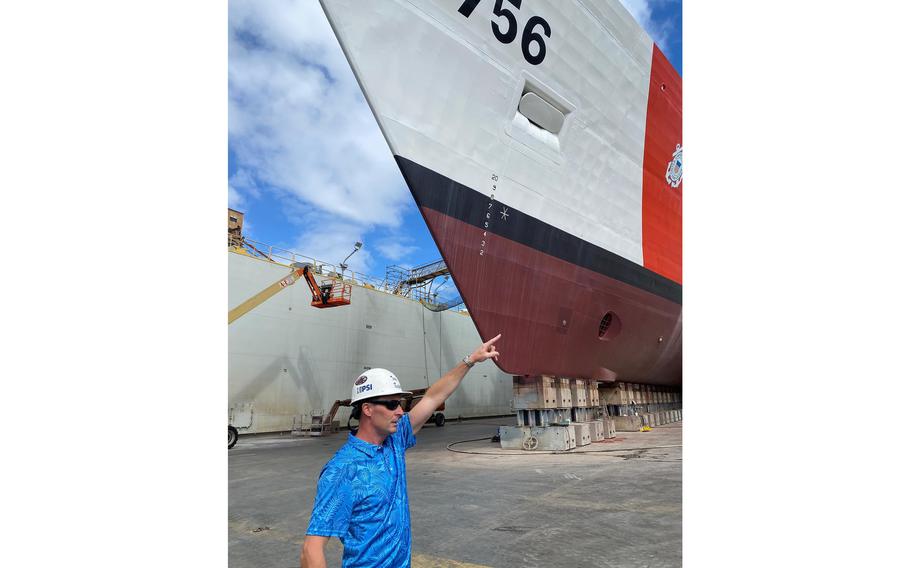
Pacific Shipyards International wrapped up its biggest maintenance project yet at its Honolulu Harbor facility, where shipyard workers over 90 days put the Coast Guard’s CGC Kimball, one of the service’s large national security cutters, through its first dry dock maintenance period. (Navy League of the United States, Honolulu Council/Facebook)
(Tribune News Service) — Over the weekend, Pacific Shipyards International wrapped up its biggest maintenance project yet at its Honolulu Harbor facility, where shipyard workers over 90 days put the Coast Guard's CGC Kimball, one of the service's large national security cutters, through its first dry dock maintenance period.
"This is the longest ship we've docked here," said Iain Wood, president and CEO of PSI.
Commissioned in 2019, the Kimball is the Coast Guard's seventh national security cutter and, along with the CGC Midgett, is one of two home-ported in Honolulu. The two vessels belong to one of the Coast Guard's largest class of vessels at 418 feet long, 54 feet wide, with a water displacement of 4,500 long tons and an operating range of 12,000 nautical miles. Getting the contract to work on them required PSI to set up a new dry dock.
"PSI invested in the new dry dock to support Hawaii's commercial and (military) maritime community," Wood said. "In anticipation of the national security cutter's arrival in Hawaii, we purposefully designed the dry dock and specialty docking towers to safely support the cutter, so it is very gratifying to have successfully completed its repair and maintenance in our dry dock."
The Kimball has already made multiple deployments in the Pacific. Most recently, the vessel and its crew performed a 42-day, 10,000-nautical-mile western Pacific patrol, making its way to Japan to train with the Japanese coast guard before returning to Honolulu in March. Service at sea can take a heavy toll on vessels as they navigate sometimes stormy weather, while the salty water and air corrode the metal ships.
"We went through about 3,000 gallons of paint, " said PSI vice president Troy Keipper. "Sometimes, when ships dry-dock, they'll only paint certain portions of it because they only want to stay out of service for so long. This was an entire packet, we painted the underwater hull, the freeboard, the superstructure and the mast."
The Coast Guard is playing an increasingly central role in U.S. Pacific policy. As it steps up operations, maintenance needs come with it. In Hawaii, Pearl Harbor Naval Shipyard is the state's single-largest industrial employer and is always busy, but the Coast Guard is largely reliant on privately owned facilities in Honolulu Harbor.
"We generally can't use Pearl Harbor," said retired Adm. Paul Zukunft, a former Coast Guard commandant. "We have to factor in the cost of the gate guards, the yard maintenance and so it becomes cost prohibitive to use Pearl Harbor."
That means more work for PSI, but it's a demanding job.
"That 90-day schedule seems like a lot of time, but it's not a lot, " Wood said. He said that lately crews had put in more seven-day workweeks than usual, "which is not always great for workers or to actually maintain a schedule; it's pretty tough."
Coast Guard District 14, which is headquartered in Honolulu, is the Coast Guard's largest area of operations. It is tasked with operations across Oceania and into the western Pacific with just 10 vessels. It conducts a wide range of missions, including search and rescue, and often is called upon by island nations that lack their own resources to help mariners in distress.
Lately, fishery enforcement has become a top priority. In 2020, the service reported that it now ranked illegal fishing above high-seas piracy as the No. 1 maritime global security threat as fish stocks rapidly deplete, threatening the food security and economies of coastal communities that depend on them and fueling confrontations over fishing rights in dwindling fisheries.
The Coast Guard has increasingly partnered with countries throughout the Pacific to track fishing activity. But for senior policymakers, the increased interest in tracking fishing boats isn't just about fish.
The world's largest fishing fleet is China's state-subsidized fleet. In 2020, the leaders of the Navy, Marine Corps and Coast Guard wrote that China "deploys a multilayered fleet" that includes "naval auxiliaries disguised as civilian vessels." These so-called maritime militias have been used to conduct surveillance missions in support of China's conventional navy and to stake out disputed territories in the South China Sea.
(c)2023 The Honolulu Star-Advertiser
Visit www.staradvertiser.com
Distributed by Tribune Content Agency, LLC.